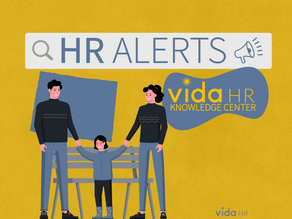MAY 2025
TABLE OF CONTENTS
TABLE OF CONTENTS
TABLE OF CONTENTS
TABLE OF CONTENTS
TABLE OF CONTENTS

REGISTER NOW!

- This course is offered for free to all Vida HR Clients -
Description:
You are invited to attend Vida HR's first "Power Session": training sessions designed to be 30 minutes or less and full of helpful information.
Invite your leaders and participate in our first Power Session: Communicating Toward Engagement.
‘Communicating Toward Engagement’ will teach you to use effective communication skills to engage and empower your employees.
Topics Include:
Inclusive Communication Styles
Empowering Employees with Two Way Communication
Is It Time to Add an
Emergency Savings Program to Your Benefits Package?

Unexpected expenses can derail even the most well-intentioned financial plans. Whether it’s a flat tire, medical bill, or sudden home repair, nearly 6 in 10 U.S. adults say they would struggle to cover a $1,000 emergency expense. That financial stress does not stay at home—it shows up at work in the form of distraction, absenteeism, and increased reliance on 401(k) loans or hardship withdrawals.
That’s why more organizations are exploring solutions like SecureSave, a dedicated emergency savings program designed to help employees build financial stability—without touching their retirement savings or, worse, turning to a predatory payday loan.
Even modest contributions, supported by employer incentives, can make a meaningful difference. For example, with $25 per paycheck (based on a typical 24- or 26-pay-period year), an employee can build up $1,000 in about 40 weeks. That timeline shortens considerably if the employer adds a modest match—just $10–$15 per paycheck could help employees reach their goal faster, while reinforcing
Why It Works:
-
Immediate access to funds without penalty or red tape
-
No loans—employees can use their own money for any reason
-
Simple payroll integration with low administrative lift
-
Optional employer incentives like a sign-up bonus, paycheck match, and milestone bonuses
-
No contribution or withdrawal limits
Programs like SecureSave are designed to integrate easily with payroll systems and do not require the administrative overhead or fiduciary responsibility of a retirement plan. Implementation is straightforward, and employees manage their own accounts directly through an app or online portal.
Financial stress is not just a personal issue, it is a business issue.

According to PwC’s 2023 Employee Financial Wellness Survey,
60% of full-time employees are stressed about their finances, even those earning over $100,000 annually.

That stress takes a toll on workplace engagement:
-
44% of financially stressed employees say personal finances distract them at work
-
56% of those distracted spend three or more hours per week dealing with financial issues on the clock
-
Stressed employees are twice as likely to be job hunting and more likely to leave for a company that demonstrates financial care
We are Here to Help
We’ve explored what an emergency savings benefit could look like using a SecureSave-style model and found the structure to be practical, flexible, and well-aligned with overall employee well-being goals. Whether rolled out in 2026 or later, it is a concept worth strong consideration for organizations looking to support financial resilience in a meaningful way.
While we are not affiliated with or integrated with SecureSave, we’ve had a great experience working with one of their representatives and are happy to make an introduction if you would like more information.
Let us know if you’d like a copy of our sample policy or want to explore how this could work for your team.



Corrective Actions
Did you know that iSolved offers a way to track corrective actions within the system?
Corrective Actions in iSolved include email notification options to assigned users for when a Corrective Action is taken, can be sent to prompt a user to initiate a corrective action, and/or to provide an assigned user with next steps.
Corrective Action Types:

Actions Taken:

Applicable Users:

iSolved offers an “Employee Corrective Action Report” to provide all employee Corrective Action information for the specified time frame.
Corrective Action information can be made accessible for employees, managers, supervisors, and HR Admin viewers through the self-service or limited to specific users – access is customizable depending on your specific needs.

Corrective Actions can be used as a stand-alone feature in iSolved or can be paired with Occurrence Tracking, which is an additional per employee per month add-on feature that allows tracking of employee points related to attendance and timekeeping policies.
If you are interested in tracking Corrective Actions and/or Occurrences within the iSolved platform, reach out to your Vida HR service team for more information!


QUESTION:
I just found out one of my managers created a private Slack channel with a few of their favorite employees. It started as a project discussion group, but now they’re venting about other staff—by name. One of the employees who was talked about found out and is threatening to quit. What should I do? Can I discipline the manager?

Is a gossip Teams/Slack channel grounds for termination / firing?
Answer:
While this may seem like a relatively new issue on the surface, at its core, it’s a classic workplace problem: exclusion, poor judgment, and a breach of professional boundaries by someone in a leadership role.
The first step is to conduct a prompt, neutral review of the Slack messages in question. It is important to determine whether the comments were isolated lapses in judgment or part of a broader pattern of exclusion, gossip, or even harassment. The intent behind the messages matters, but the impact on team culture and trust is just as significant, especially when an employee is considering quitting as a result.
If the behavior involved confidential information, targeted bullying, or clear violations of company policy, disciplinary action up to and including termination may be appropriate. If the messages were inappropriate but not malicious, it may be an opportunity for corrective coaching, a formal warning, and additional leadership training. Either way, the manager’s actions must be addressed clearly and directly.
It is also critical to support the affected employee. Acknowledging what happened, listening to their concerns, and outlining steps being taken can help rebuild trust and potentially retain valuable talent.
Finally, this is a good moment to reinforce expectations around digital communication. Slack, Teams, and similar tools may feel informal, but company values and policies still apply, especially for those in leadership roles.
When handled with transparency and consistency, a situation like this can serve as a turning point, reinforcing the kind of respectful, inclusive culture that every organization should strive to maintain.

















